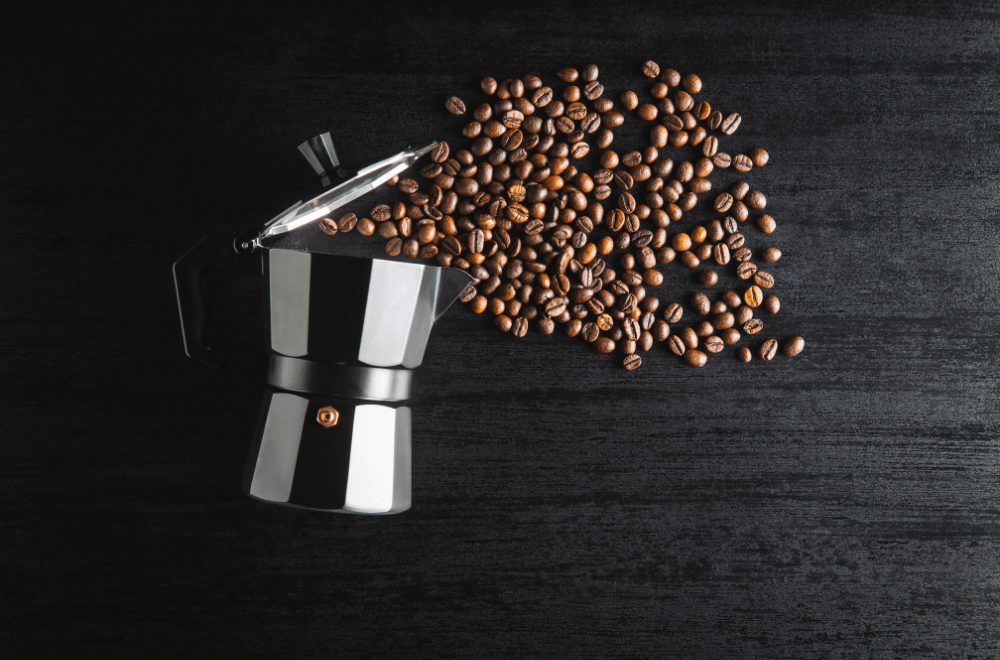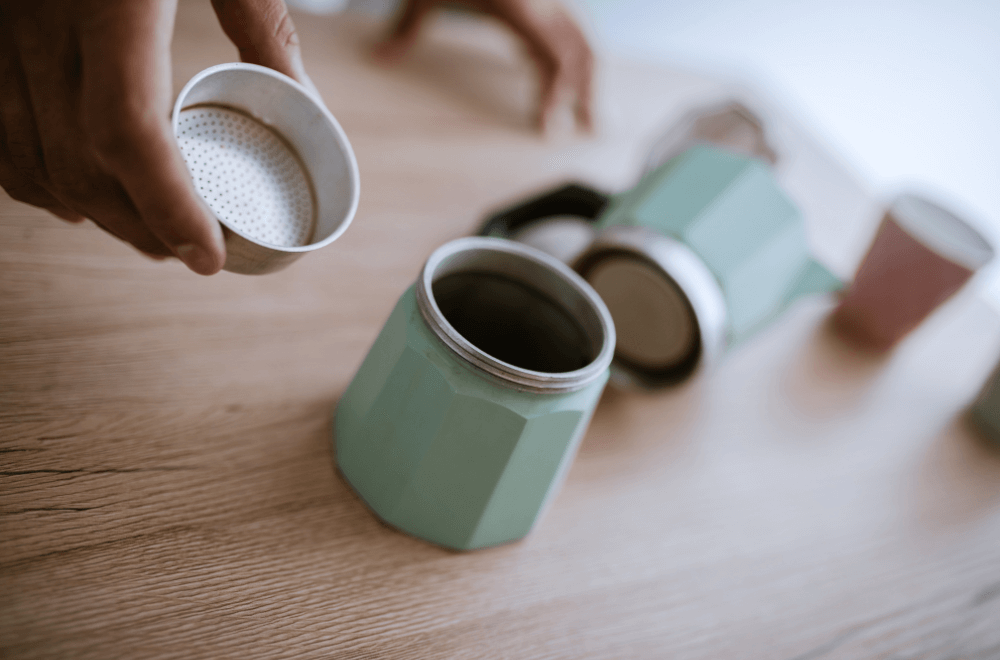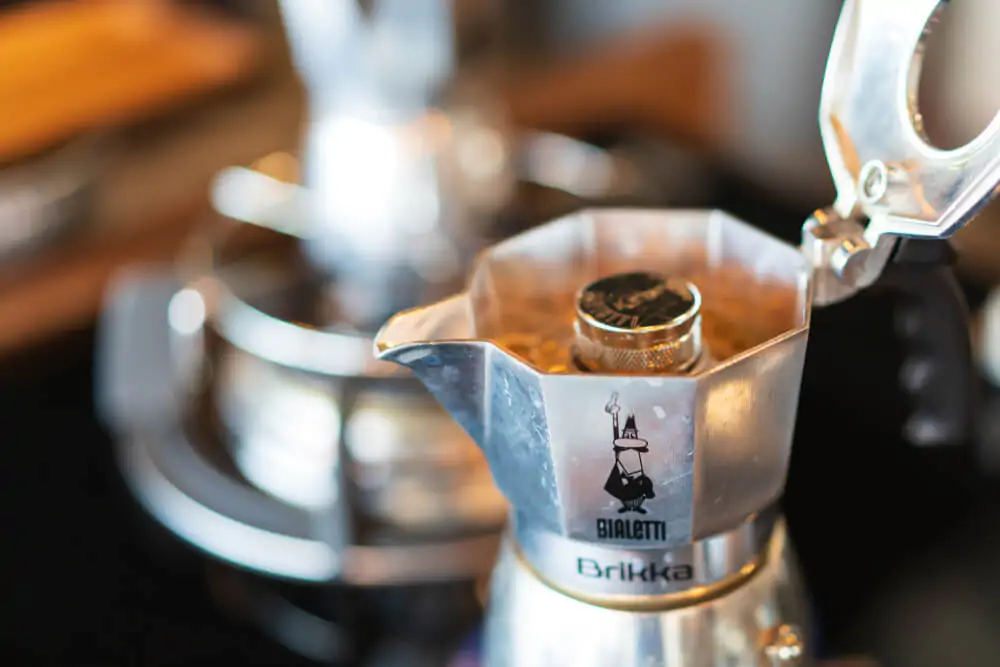Dig into this Moka pot history to discover the story behind the invention of a famous Italian design that has stood the test of time since its 1933 launch.

Born with a clear vision in mind: making espresso-style coffee easier at home without fancy coffee machines, the Moka pot is one of the greatest inventions in the coffee industry made by Alfonso Bialetti, an Italian engineer.
The name “Moka pot” is derived from the City of Mocha in Yemen. This area plays host to a bustling trading port of AI-Mukka that has been long known for its coffee trade. Other popular names for Moka pots are caffettiera, macchinetta, and stovetop espresso maker.
After nearly 100 years since it was first introduced in 1933, the Moka pot is still widely used worldwide as it is inexpensive, effective, and sturdy. From New York to Milan, this Italian coffee icon has transformed from humble post-war ingenuity to culinary dominance. This article will walk you through the major milestones in the history of the Moka pot.
1800s – 1919: Before The Moka Pot
The Moka pot was not the first stovetop coffee maker introduced to Italian people. Before the Moka pot, Napoletana swept through Italy as a national favorite home brewing method.
Napoletana is a flip coffee pot that’s also known as a cuccuma. It was invented in the 1800s and included two chambers. One needed to be filled with water, and the other one stayed empty.
Once it was set, you would place the whole unit on the stovetop. When the water boiled, you would flip the entire pot to force the hot water into the ground coffee, so the extraction dripped through the other chamber.
Napoletana is a few decades older than Moka pot. The two methods are similar in design but perform in two completely different ways. Napoletana used percolation, while Moka pots will use steam pressure to extract – and that’s why the Moka pot is ahead of the game.
When Alfonso Bialetti invented the Moka pot at the turn of the 20th century, it became the first coffee maker that guaranteed barista-style coffee for home use.
Think of the Moka pot as a combination of La Pavoni, the world’s first espresso machine, with the stovetop Napoletana. Bialetti incorporated modern design elements of Futurism and Art Deco into the device’s configuration. On top of that, he also borrowed unique features from already-popular coffee services such as Hénin and Puiforcat to finalize the unmistakable octagonal form you see today.
1919 – 1933: The ‘Eureka’ Moment
Bialetti’s first encounter with the idea of the Moka pot came around during his time at an aluminum workshop in 1909. Ten years later, he returned to Piedmont, a region in northwest Italy, to run his own aluminum workshop, where he produced goods using shell molding.
Not until 1933 did the inspiration for the Moka pot strike. A usual daily chore turned into a life-changing event as Bialetti’s wife was doing the laundry.

She used a bucket with a lid on top and a tube in the middle; the bucket was filled with soapy water waiting to be boiled. When it reached the boiling point, the steam traveled through the tube and diffused to the laundry area hanging above.
Bialetti thought it was a great idea, and he realized that he could make the exact same device – but for coffee, so he created a handy home brewer, which would change how Italians drink coffee forever. His invention of the Moka pot was supported by Luigi De Ponti, who designed the structure of the device.
The Moka pot was brought to life in 1933. Bialetti named it Moka Express. Even though it didn’t see immediate awareness from the market after its release, the Moka Express gradually became one of the culinary staples in Italian coffee culture.
This octagonal device is usually made of aluminum or stainless steel and comes with bakelite handles. Break it apart, and you will see a lower chamber wrapping around a filter basket that you fill with ground coffee; there is also an upper chamber that is sealed tightly on top with a lid. Learn more in our aluminum Moka pot vs. stainless steel guide.
This bottom chamber contains hot water. When the whole unit is properly assembled, you place it on top of low heat to start the brewing. Boiling water creates a steam pressure that slowly absorbs the ground coffee for extraction.
After about five minutes, the finished coffee spills into the upper chamber from the metal tube in the middle. Sometimes, you will hear your Moka gurgling at the end of the cycle. That is when the last pockets of water are forced through the filter into the spout, signaling the coffee is ready to serve.
1933 – 1955: A Post-War Resurgence
When the Moka pot came to life, Bialetti started to promote his products by selling them at public markets in Piedmont, his hometown. Bialetti also partnered with some retailers he had been working with during his time at the aluminum workshop to boost sales.
He had no intention of scaling up his production of Moka pots and advertising them in a national campaign. Before 1939, there were only about 70,000 Moka pots sold.
When World War II broke out in 1939, a majority of aluminum products made in Italy and imports went into war materials, leaving a tiny fraction for making household appliances. The shortage of capital goods discouraged the development of Bialetti’s workshop and led to a temporary closure.
Misfortunes never come in singly; Bialetti’s son, Renato Bialetti, was held hostage in Germany as a war criminal. But every cloud has a silver lining; Renato was soon released after the war ended in 1946.
Alfonso and Renato opened the workshop and got it running again. Renato also became his father’s right-hand man and contributed greatly to the success of the Moka pot.
As Italy entered a new chapter of the post-war economy, people yearned for a return to normal. The Bialetti family seized the opportunity to set out for the mass production of Moka pots.
The resurgence of Moka Express was a massive hit in 1953 with the iconic logo of Omino coi Baffi. Translated into “the little man with a mustache,” Omino coi Baffi burlesqued Alfonso’s appearance printed on every single Moka pot.
Along with the famous logo, the slogan “in casa un espresso come al bar” (an espresso at home just like at the bar) also came around. There was a time when Bialetti even displayed a giant 53-foot-tall Moka pot sculpture at the entrance of the Milan Fair Trade.
1555 – 1957: A Boost In Brand Awareness With Television Commercials
Moka Express’s reputation went into overdrive from 1955 to 1957 when TVC was a huge deal in Italy. It dedicated a 10-minute spot every night for advertising, and Bialetti made it to the top of the list of frequent visitors.
Moka Pots Today
To meet the rising international demand, Bialetti now introduces a wide range of colors and sizes for its Moka Express. From classic grey stainless steel to later-colored versions, including black, red, blue, green, gold, and even one with the colors of the Italian flag, you have a lot more fun choosing your favorite coffee brewers these days.
For larger brews in coffee shops, the brand has developed bigger Moka pots available from six cups to 18 cups. Check out our explainer on can you use a Moka pot on a glass stove.
A Timeless Design Icon Of Italian Coffee
After nearly a century, Bialetti Moka Express is still one of the most widely-found items in many Italian homes, despite the growing need for fancy espresso machines. Easy to use and transport, Moka pots make perfect strong coffee at home, so people don’t have to run into any espresso bar just to look for a decadent beverage.

However, not every Italian family makes Moka coffee the same way. It comes down to a matter of taste.
Some like it a bit watered down, while some even tamp their ground coffee during the brewing process (even though vigorous tamping is strongly dissident). Italians also have their own ways of enjoying Moka pot coffee; some like black coffee and some prefer sweetener and milk.
Today, Lavazza, Illy, and Segafredo are some of the best Italian brands for Moka pots. Other notorious global brands also joined the game, including Alessi, Cuisinox, Serafino Zani, Bellman, Top Moka, and G.A.T. However, Bialetti is still the head of the line.
Over 300 million Bialetti units have been sold since its launch. There was a time when Bialetti was pushed to the brink of extinction, but this indestructible icon found its way back. The global pandemic ironically did more good than harm when coffee bars across Italy remained shut, forcing people to turn to their kitchens for coffee.
For that reason, Bialetti finally got a hold of its position. Today, this timeless design sits in various museums worldwide, including the Wolfsonian-FIU, NYC Museum of Modern Art, the Cooper–Hewitt, National Design Museum, London’s Design Museum, and Science Museum.
FAQs On Moka Pot History
What Is The Difference Between A Moka Pot And A French Press?
A Moka pot brews coffee by creating a steam pressure that extracts the ground coffee in the filter basket. With a French press, you need to soak ground coffee completely in water and decant it to extract the brew. The Moka pot works best with medium-fine coffee, while a French press performs best with coarser grinds.
What Is The Most Popular Type Of Coffee For A Moka Pot?
Opt for a medium roast with a medium-fine grind size for the best Moka Pot brew. This roast profile aims to produce an excellent espresso coffee with a rich flavor and hints of chocolate or roasted nuts.

